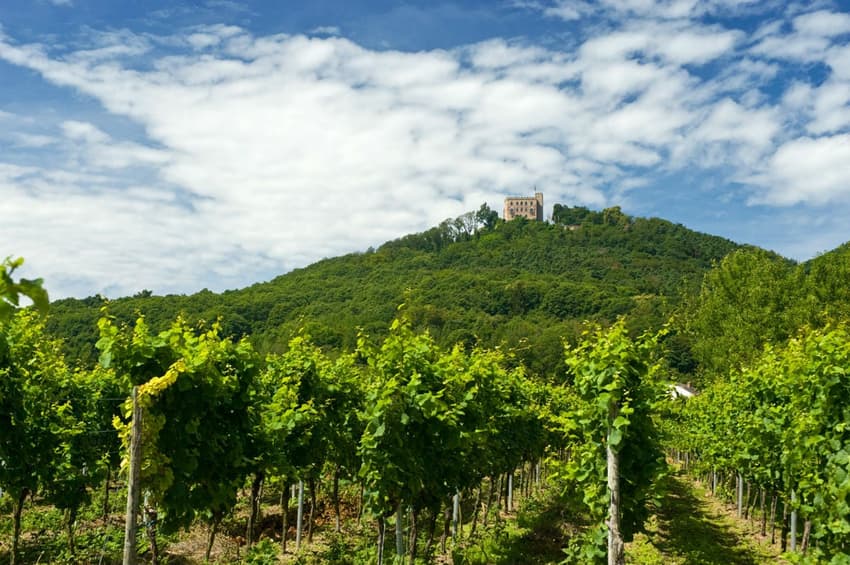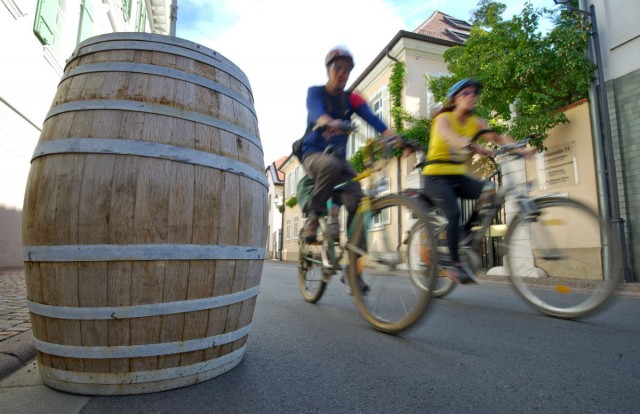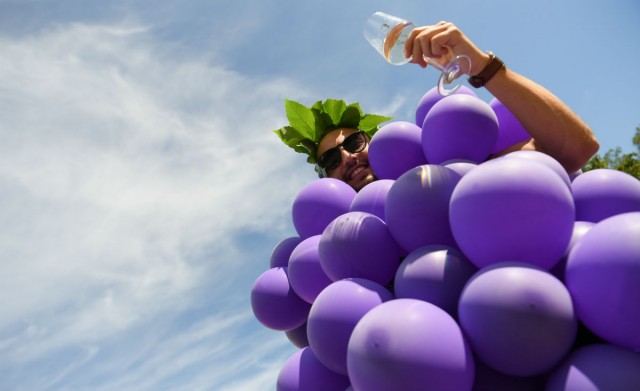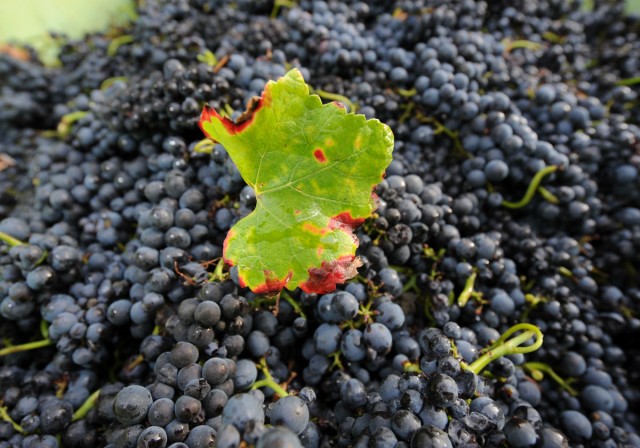5 things you really should know about wine in Germany

While Germany might not be the first country people think of when it comes to wine, it has a heck of a lot to offer - and we're not just talking about its famed Riesling white grape variety.
1. Germany is the eighth largest wine-producing country in the world
Yes, Germany actually produces wine. In fact, some of the country’s oldest plantations date back to the Roman era.
Nowadays, 60% of wine production in Germany takes place in the state of Rhineland-Palatinate, much of it along the river Rhine.
There are also plenty of wine regions to choose from. From Baden to Mosel to the Rheinhessen, there are 13 official wine regions in Germany and each of them is unique in its own way, so it really depends on what you’re looking for.
Baden, for instance, is the longest wine region in Germany. At about 400 kilometres long, it reaches Basel, Switzerland at its southern tip. It’s also the warmest and sunniest wine-growing region.
The largest wine region in the country is the Rheinhessen, known for its Liebfraumilch wine - a semi-sweet white wine - which dates back to the mid 1700s.
2. You can hop in a car and check out several of Germany’s wine regions along its renowned Weinstraße (Wine Road)
Established in 1935, Germany’s Wine Road is one of the oldest wine tourist routes worldwide. At 85 kilometres long, it stretches from close to the French town of Wissembourg in the south and ends at the municipality of Bockenheim an der Weinstraße in the north.
The route is also pretty easy to follow as a yellow sign with a stylized logo of wine grapes is placed at regular intervals along the way.
Often compared to having a Mediterranean landscape, the hilly route is dotted with fig, lemon and kiwi trees. In March, almond blossom trees paint the region pink and white.
Small villages and castles can also be visited along the Weinstraße. And if you need to squeeze in a bit of relaxation during all that driving, there’s a thermal spring you can dip into at Bad Bergzabern. For entertaining the kids, visiting the rail museum in Neustadt may be handy.
 Cyclists in Deidesheim during German Wine Route Day in 2011. Photo: DPA.
Cyclists in Deidesheim during German Wine Route Day in 2011. Photo: DPA.
Make sure to ditch your car on the last Sunday in August, though. On this day, the route is closed to motorized traffic for Erlebnistag Deutsche Weinstraße (German Wine Route Day) and wineries and wine bars open their doors to thousands of bicyclists, inline skaters and hikers.
3. Late summer is the time to take advantage of wine festivals
If you can’t make it out to the actual vineyards, it’s not at all too late to visit the many wine festivals taking place all across Germany in small villages, large towns and cities.
From August 31st to September 3rd, the Bremer Weinfest in Bremen will host 20 vintners from the country's various wine regions.
Germany is also host to the Dürkheimer Wurstmarkt in Bad Dürkheim, which stands out as the world’s biggest wine festival that welcomes over half a million visitors each year. The festival takes place on the first and second weekend in September and has been celebrated for the past 600 years.
 A man dressed in an appropriate costume in Bad Dürkheim in 2016. Photo: DPA.
A man dressed in an appropriate costume in Bad Dürkheim in 2016. Photo: DPA.
While in Bad Dürkheim, don’t miss the giant wine barrel in town. You won’t be able to drink any wine from it, but you can eat inside it as it houses a restaurant.
August 30th marks the kickoff of the Stuttgarter Weindorf wine festival, where in the evening on that day, you can try your hand at winning free tickets for a hot-air balloon ride. The city of Stuttgart is transformed into a festive wine village until September 10th, where there's not only an emphasis on regional wines, but Swabian food specialities such as Maultaschen and Käsespätzle too.
4. Riesling is a favourite, but don’t let that deter you from trying other types of German wines
White wine accounts for almost two thirds of total wine production in Germany. While it’s arguable that all of the country’s best wines come from the Riesling grape, there are many other white wines worth trying.
The Riesling white grape variety originated from the Rhine region and is characterized by its flowery aroma, high acidity and semi-sweet taste. But Gewürztraminers are another excellent grape. Less than one percent of German wine regions are covered with Traminer vines and their yields are small, making the wine a rare specialty. Gewürztraminer wines are light yellow in colour and mildly acidic with aromatic hints of roses, honey and oranges.
Due to the country’s climate, the production of red wine in Germany isn’t as significant as its production of white wine. But it’s worth noting that red wine production surged in the country in the 1990s and early 2000s, due in part to domestic demand.
 Pinot Noir grapes. Photo: DPA.
Pinot Noir grapes. Photo: DPA.
Nowadays, domestic demand for red German wines continues to grow. In fact, when high-ranking officials took a break from diplomatic talks at the recent G-20 summit in Hamburg, German Chancellor Angela Merkel served her guests German Pinot Noirs. Pinot Noir is the country’s most popular red grape variety with typical red fruit aromas such as cherries and raspberries.
Germany is the third largest Pinot Noir producer worldwide.
5. Warmer temperatures have been positive for German wines
While climate change means bad news for all, the warmer temperatures have brought good news for Germany's wine growers in the past.
Since Germany is located in the northern hemisphere, generally considered a cooler country and the best wines produced in the country are grown in the warmest years, climate change and warmer years don’t translate to wines with less flavour, but rather the opposite.
Hotter weather has had a positive impact on wines in Germany, meaning that there’s no better time to enjoy a glass from your nearest wine region as German Rieslings and Pinot Noirs are currently more full-flavoured than before.
Comments
See Also
1. Germany is the eighth largest wine-producing country in the world
Yes, Germany actually produces wine. In fact, some of the country’s oldest plantations date back to the Roman era.
Nowadays, 60% of wine production in Germany takes place in the state of Rhineland-Palatinate, much of it along the river Rhine.
There are also plenty of wine regions to choose from. From Baden to Mosel to the Rheinhessen, there are 13 official wine regions in Germany and each of them is unique in its own way, so it really depends on what you’re looking for.
Baden, for instance, is the longest wine region in Germany. At about 400 kilometres long, it reaches Basel, Switzerland at its southern tip. It’s also the warmest and sunniest wine-growing region.
The largest wine region in the country is the Rheinhessen, known for its Liebfraumilch wine - a semi-sweet white wine - which dates back to the mid 1700s.
2. You can hop in a car and check out several of Germany’s wine regions along its renowned Weinstraße (Wine Road)
Established in 1935, Germany’s Wine Road is one of the oldest wine tourist routes worldwide. At 85 kilometres long, it stretches from close to the French town of Wissembourg in the south and ends at the municipality of Bockenheim an der Weinstraße in the north.
The route is also pretty easy to follow as a yellow sign with a stylized logo of wine grapes is placed at regular intervals along the way.
Often compared to having a Mediterranean landscape, the hilly route is dotted with fig, lemon and kiwi trees. In March, almond blossom trees paint the region pink and white.
Small villages and castles can also be visited along the Weinstraße. And if you need to squeeze in a bit of relaxation during all that driving, there’s a thermal spring you can dip into at Bad Bergzabern. For entertaining the kids, visiting the rail museum in Neustadt may be handy.
 Cyclists in Deidesheim during German Wine Route Day in 2011. Photo: DPA.
Cyclists in Deidesheim during German Wine Route Day in 2011. Photo: DPA.
Make sure to ditch your car on the last Sunday in August, though. On this day, the route is closed to motorized traffic for Erlebnistag Deutsche Weinstraße (German Wine Route Day) and wineries and wine bars open their doors to thousands of bicyclists, inline skaters and hikers.
3. Late summer is the time to take advantage of wine festivals
If you can’t make it out to the actual vineyards, it’s not at all too late to visit the many wine festivals taking place all across Germany in small villages, large towns and cities.
From August 31st to September 3rd, the Bremer Weinfest in Bremen will host 20 vintners from the country's various wine regions.
Germany is also host to the Dürkheimer Wurstmarkt in Bad Dürkheim, which stands out as the world’s biggest wine festival that welcomes over half a million visitors each year. The festival takes place on the first and second weekend in September and has been celebrated for the past 600 years.
 A man dressed in an appropriate costume in Bad Dürkheim in 2016. Photo: DPA.
A man dressed in an appropriate costume in Bad Dürkheim in 2016. Photo: DPA.
While in Bad Dürkheim, don’t miss the giant wine barrel in town. You won’t be able to drink any wine from it, but you can eat inside it as it houses a restaurant.
August 30th marks the kickoff of the Stuttgarter Weindorf wine festival, where in the evening on that day, you can try your hand at winning free tickets for a hot-air balloon ride. The city of Stuttgart is transformed into a festive wine village until September 10th, where there's not only an emphasis on regional wines, but Swabian food specialities such as Maultaschen and Käsespätzle too.
4. Riesling is a favourite, but don’t let that deter you from trying other types of German wines
White wine accounts for almost two thirds of total wine production in Germany. While it’s arguable that all of the country’s best wines come from the Riesling grape, there are many other white wines worth trying.
The Riesling white grape variety originated from the Rhine region and is characterized by its flowery aroma, high acidity and semi-sweet taste. But Gewürztraminers are another excellent grape. Less than one percent of German wine regions are covered with Traminer vines and their yields are small, making the wine a rare specialty. Gewürztraminer wines are light yellow in colour and mildly acidic with aromatic hints of roses, honey and oranges.
Due to the country’s climate, the production of red wine in Germany isn’t as significant as its production of white wine. But it’s worth noting that red wine production surged in the country in the 1990s and early 2000s, due in part to domestic demand.
 Pinot Noir grapes. Photo: DPA.
Pinot Noir grapes. Photo: DPA.
Nowadays, domestic demand for red German wines continues to grow. In fact, when high-ranking officials took a break from diplomatic talks at the recent G-20 summit in Hamburg, German Chancellor Angela Merkel served her guests German Pinot Noirs. Pinot Noir is the country’s most popular red grape variety with typical red fruit aromas such as cherries and raspberries.
Germany is the third largest Pinot Noir producer worldwide.
5. Warmer temperatures have been positive for German wines
While climate change means bad news for all, the warmer temperatures have brought good news for Germany's wine growers in the past.
Since Germany is located in the northern hemisphere, generally considered a cooler country and the best wines produced in the country are grown in the warmest years, climate change and warmer years don’t translate to wines with less flavour, but rather the opposite.
Hotter weather has had a positive impact on wines in Germany, meaning that there’s no better time to enjoy a glass from your nearest wine region as German Rieslings and Pinot Noirs are currently more full-flavoured than before.
Join the conversation in our comments section below. Share your own views and experience and if you have a question or suggestion for our journalists then email us at [email protected].
Please keep comments civil, constructive and on topic – and make sure to read our terms of use before getting involved.
Please log in here to leave a comment.